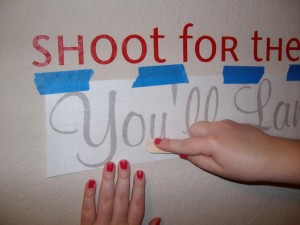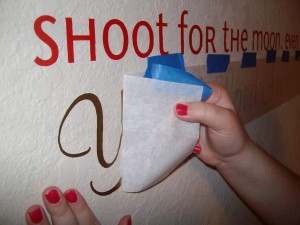
While vinyl is usually very easy to apply on most surfaces, canvas can be a difficult one. Vinyl decals adhere better to smooth surfaces, and canvas is rough enough that it can create air pockets and overall be quite hard to get vinyl to stick to.
Vinyl can stick to canvas, as long as you take your time to prepare and apply it properly. Before we get started, make sure that you are using high quality, commercial grade vinyl. Using thick, sticky vinyl will not only make applying it easier, it will help your crafts and signs to last longer.
Our glossy vinyl or Oracal 651 are the best choices for crafts with canvas, as they have more adhesive than regular or matte vinyl types.
Prepping Your Canvas for Vinyl
Vinyl decals can adhere much better if you make the surface of the canvas smooth. One popular and easy way to prepare your canvas is by painting it. This fits right in with many crafts, and is inexpensive. If you’re not changing the background color at all, using a spray adhesive or mod podge is probably your best bet. When using a spray adhesive, make sure to let it dry before applying your vinyl.
Applying Vinyl to Canvas
Applying vinyl to canvas is similar to applying vinyl to a wall or other surface, but requires a few extra steps after you’ve prepared it as described above.
- Set the canvas on a firm surface
Place the canvas on a hard, flat surface so that you can rub the vinyl on later. The best method for this is putting the canvas on top of a hardback book. Choose a book that will fit inside the frame around your canvas so that the canvas lies directly on top of it.
- Place the vinyl on top of the canvas
Gently set the vinyl in its desired location on top of the prepared canvas. Make sure that it is in the final position that you want.
- Rub on the vinyl
Starting in the middle, smooth the vinyl outward. Next, use a tennis ball or an old credit card to rub the back of the decal. The longer and more firmly you rub, the easier the vinyl will come off the transfer paper and stick to the canvas. Rubbing the decal helps the vinyl stick into any remaining crevices.
- Peel back the transfer paper
Carefully peel back the transfer paper. If any sections of vinyl or letters stick to the paper or don’t stay on the canvas, place the transfer paper back on top of them and rub some more. You can also carefully heat the vinyl using a hair dryer on low power.
Related: How to Get Wall Decals to Stick
Do I need to seal vinyl on canvas?
You do not need to seal vinyl on canvas. Actually, it can keep the vinyl from adhering properly to the canvas, so it is better not to seal it. Sealing vinyl on canvas can cause air bubbles or even cause the decal to deform.
In addition, the vinyl does not need a sealant to stay on the canvas. When properly applied, good vinyl will stick perfectly fine long term to canvas without a sealing agent.
How to remove vinyl from canvas
Removing vinyl from canvas is a delicate process. Depending on the craft that you are removing it from, some of the conventional tips may not work or be practical.
Unless your craft is heat sensitive or could dry out/crack if heated, use a hair dryer (on low power) to make the adhesive more pliable. Gently peel it up using tweezers or your fingernails. This shouldn’t be too difficult, especially with the difficulties of getting vinyl to stick to canvas in the first place.
Related: How to Remove Wall Decals Without Damaging Paint
If you need inspiration or have any further questions about getting your vinyl to stick to canvas, check out our FAQ or reach out on our Facebook page! We would love to help you with your projects. Feel free to also share your crafts on our Facebook page or tag us in your post. Happy crafting!














